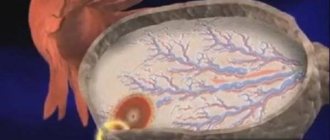Premenstrual syndrome is a concept familiar to many women of reproductive age. What is he? First of all, this is a complex of symptoms that appear in the second phase of the menstrual cycle. In most cases, PMS is accompanied by painful symptoms that disrupt the natural lifestyle and negatively affect the ability to work. During this period, a woman becomes irritable, emotionally unbalanced, she can cry over trifles, and become despondent. As a rule, premenstrual syndrome begins to appear a few days before your period.
Premenstrual pain in the lower abdomen: statistics
Scientists conducted research and found the following: over the past decade, the number of women who experience premenstrual pain in the lower abdomen has almost doubled. Today this number is about 40%. Most often this is due to an unhealthy lifestyle, environmental degradation, and an unbalanced diet.
10% of women experience particularly severe abdominal pain, which makes them unable to work. As a rule, this is associated with dysmenorrhea. In addition, before menstruation, the stomach, legs, lower back, insomnia may hurt, and irritability may also appear.
Premenstrual pain in the lower abdomen: natural causes
Pain in the lower abdomen before the onset of menstruation does not always indicate serious problems. Of course, in this case it should not interfere with a woman’s life. The pain can be nagging, aching, cramping, but not very intense.
Here are the main causes of pain in the lower abdomen before menstruation: - reduction in the amount of endorphins; - PMS; - stress, psychological and emotional disorders; - non-compliance with the daily routine, lack of adequate nutrition, rest and sleep.
So, the first reason is a decrease in the amount of endorphins. These hormones are considered endogenous opiates. They are also called happiness hormones. Endorphin secretion is stimulated by estrogen and progesterone. One week before the onset of menstruation, progesterone levels reach their maximum, while the amount of estrogen decreases. However, just before menstrual bleeding itself, the amount of both hormones is significantly reduced. Accordingly, the level of endorphins decreases.
Such noticeable hormonal surges affect the entire female body. In particular, the amount of magnesium and potassium in it changes. Possible cramps, stress, chest pain before menstruation, pain in the lower abdomen. The CNS (central nervous system) senses a decline in hormones, and as a result, changes in emotional, physical and mental state occur.
If PMS significantly impairs quality of life, it must be treated.
Recurrent pain may occur due to premenstrual syndrome (PMS). This reason is especially likely if you have 5 more signs from the list: - an inexplicable desire to cry; - depressed state; - depression; - aggression or anxiety; - feeling of uselessness or hopelessness; - loss of interests; - desire to hide from others, - increased fatigue; - sharp increase in appetite; - inability to concentrate; - insomnia or drowsiness; - swelling of the limbs; - bloating; - breast pain; - feeling of a lump in the throat or lack of air; - headache.
Common reasons
There are several factors that provoke the development of PMS:
- Failures in the process of water-salt metabolism.
- Heredity. If the mother suffered from symptoms of PMS, the likelihood that her daughter will also experience it increases.
- A large number of stressful situations.
- Changes in the levels of the hormones estrogen and progesterone.
- Activation of prolactin production.
- Disorders of the thyroid gland.
- Unbalanced diet, insufficient amounts of vitamins and minerals, such as magnesium, calcium and zinc.
- The production of substances in the brain that affect the general condition of a woman.
All these changes affect both mood and overall well-being. But there are other factors that are responsible for a woman feeling pain.
Premenstrual pain in the lower abdomen: functional disorders
Before menstruation, the stomach may hurt due to anatomical features or diseases: - functional disorders in the endocrine system; - congenital underdevelopment or displacement of the uterus; - inflammatory process; - fibroids and cysts; - fibromatous nodes.
If you experience very intense pain in the lower abdomen, you need to be examined by a gynecologist. Minor nagging pain is considered normal and does not require treatment.
The reason why pain occurs in the lower abdomen before menstruation may be a previous abortion. Such pain may be felt for several cycles and then goes away.
Severe premenstrual pain in the lower abdomen, which is pathological, may appear due to an infectious disease of the genitourinary tract. Symptoms of infection can include not only painful periods, but also other unpleasant symptoms characteristic of a particular illness. To determine the exact cause of pain in the lower abdomen before menstruation, you should consult a doctor.
After the necessary diagnostics and a complete gynecological examination, the doctor will be able to give you the correct diagnosis. A disease detected in time greatly increases the chances of successfully getting rid of it.
Classification of the syndrome
My lower abdomen hurts a lot before my period. This is not a temporary disorder. Dysmenorrhea is listed in ICD-10, the International Classification of Diseases. In the directory it is divided into several categories:
- Primary (or functional). If before the first menstruation the lower abdomen hurts (as during subsequent menstruation), this is a completely non-pathological syndrome in this category. This is only an individual process of the menstrual cycle that does not require intervention or treatment.
- Recycled (or organic). If your lower abdomen hurts a week before your period, this may also indicate a pathological cause of the syndrome. In particular, it can be caused by diseases and structural changes in the reproductive system. For example, endometriosis, various inflammatory processes affecting the genitals, abnormalities of the genital organs, uterine fibroids, inflammation of the fallopian tubes.
- Unspecified (menstrual pain of unknown origin).
Also, according to the degree of severity, there are four types of dysmenorrhea:
- Weakly expressed.
- Moderately expressed.
- Strongly expressed.
- Maximum degree of disease.
How to reduce pain in the lower abdomen before menstruation
Antispasmodics, for example, No-shpa, can help alleviate the situation. However, doctors recommend not using painkillers too often in the days before your period. It is best to reduce pain in the lower abdomen using traditional medicine. Healing decoctions of chamomile and nettle will help improve your condition.
There are also special herbal preparations that help in such cases - for example, “Anastasia”. Such decoctions can be taken one week before menstruation, as well as during menstruation itself.
Not all women keep a schedule by which they can track the regularity and duration of their periods. Most of them quite accurately predict the start date of their next menstruation based on changes in their well-being due to physiological reasons. Pain, discomfort in the lower abdomen, and general malaise two or three days before the onset of menstruation become almost commonplace. Is it necessary to pay attention to the intensity and nature of unpleasant symptoms, depending on the woman’s overall health, hormonal balance indicators, cyclical changes in the organs of the reproductive system, and the severity of premenstrual syndrome? Moderate discomfort felt by a woman before her period is considered physiologically normal. But spasmodic acute pain and noticeable discomfort that are present before menstruation and do not subside with the onset of menstruation should alert every woman and become the basis for visiting a gynecologist.
Severe pain before menstruation or the onset of menstruation does not mean anything good.
The main causes of the syndrome
If your stomach hurts a week before your period, what could this mean? Only your gynecologist will give a specific answer. After all, dysmenorrhea can be caused not only by natural, harmless, but also by pathological causes.
If a woman is healthy, but every menstruation results in pain for her, there are two main expert explanations:
- Why did my lower abdomen hurt before my period? The first position takes into account the importance of the psychological factor, as well as the physiological type of the woman. Mostly young girls of asthenic type suffer from pain. They have a neurasthenic or labile-hysterical personality characteristic. Accordingly, anticipation of the upcoming menstruation can cause an anxiety-neurotic disorder, which leads to a psychogenic decrease in the pain threshold. This means that even minor pains are perceived by the body as stronger than they actually are.
- A few days before menstruation, my lower abdomen hurts. What could this mean? Another explanation is based on the fact that menstrual blood contains an increased concentration of prostaglandins. Those biologically active substances that regulate both the contraction of the uterus and the functioning of the vessels of this organ, the intensity of pain perception, etc. And excessive production of these substances can lead to negative consequences for the body: deficiency of uterine circulation, sharp spasms of the muscles of the organ, and an objectively strong painful sensation in the lower abdomen.
Causes of severe abdominal pain before menstruation
How to distinguish normality from pathology, because each woman has her own individual pain threshold. How to understand when abdominal pain during PMS is normal, and when severe pain in the lower abdomen on the left or right is symptoms of a pathological problem or disease. Severe pain before the onset of menstruation can be interpreted in different ways, depending on how much the woman feels the deterioration of her general condition. The body of women with a low pain threshold cannot cope with even mild pain and needs to take painkillers, but there are women who continue to live and work as usual, despite the presence of intense pain, patiently enduring them and not taking any measures. This situation confuses doctors when they hear complaints of severe pain before menstruation, so they focus on a complex of all symptoms.
The most common symptoms of the onset of premenstrual syndrome are nagging and aching pain in the lower abdomen, which can radiate to the left or right side; sometimes pain in the lower abdomen before menstruation can radiate to the lower back, lower groin, pubic area or tailbone area. But such pain before the onset of menstruation should not be severe; ideally, a woman should feel mild discomfort or moderate pain. A number of factors can negatively affect a woman’s well-being on the eve of her next menstruation:
- Excessive levels of physical exertion due to demanding work conditions or intense workouts in the gym, especially on weight machines, can cause very severe abdominal pain. Sometimes, after serious training, a woman may feel literally unbearable pain in her stomach if her period is about to begin. Strength training before your period often increases soreness, pain, and other symptoms of PMS (premenstrual syndrome).
- The reasons for increased pain before menstruation may lie in staying for a long time in cold conditions, leading to hypothermia. Due to the fact that the body gets cold, especially the legs, spasms may occur in the vessels of the pelvic organs, which increase the sensation of pain on the eve of menstruation. So, before menstruation, habitual and mild pain in the abdomen can turn into a very mild nagging or aching pain in the abdomen.
- Why do abdominal pains only get worse before menstruation? Premenstrual tension syndrome, or more simply, premenstrual syndrome (PMS). Not everyone experiences an uncomfortable state a couple of days before the start of menstruation; in some women it is felt much earlier, 5-7 days. Characteristic symptoms are dull nagging pain in the lower abdomen combined with autonomic and neurological symptoms (tachycardia, headache, sweating, numbness of the extremities). PMS is classified not as a separate pathology, but as a separate symptom complex with different clinical forms, depending on the severity of manifestations that can disrupt the usual lifestyle and limit a woman’s ability to work.
- What could happen if during these periods your stomach hurts much more than usual before menstruation? Lack of sufficient physical activity. Physical inactivity, caused by the “sedentary” principle of work and inactive rest, contributes to the development of blood supply disorders to the pelvic organs and leads to stagnation. This provokes an increase in pain, abdominal pain becomes more noticeable on the eve of menstruation.
- Excess body weight causes a lot of problems in the body, just some of them are delayed menstruation or early menstruation, too much or very scanty discharge during menstruation, very severe abdominal pain before the onset of menstruation. Little known to many is the fact that adipose tissue itself performs, among other things, an endocrine function, that is, it releases hormones, such as estrogen, into the bloodstream. A significant excess of adipose tissue can significantly affect the balance of hormonal levels, and hormonal imbalances often accompany painful menstruation.
- Diseases of the digestive system can cause very painful premenstrual syndrome. Due to pathologies of the stomach and intestines, cramps and bloating (flatulence) are often observed; irritated intestinal loops put pressure on the area of the uterus and appendages, increasing the pain during menstruation.
- Use of an intrauterine device (IUD). For some women, the IUD is an undesirable form of contraception, since it can become one of the causes of dysmenorrhea. If, after installing various types of intrauterine devices, a woman has pain in the lower abdomen and the pain does not go away, if such pain in the lower abdomen after the installation of PMS is regular and appears periodically, you should definitely seek help from a doctor.
- A number of gynecological pathologies, especially those related to the condition of the uterus. Pain of varying intensity can occur against the background of pathological changes in the muscular uterine tissues or with an abnormal anatomical structure, which negatively affects the contractility of the organ or the free outflow of menstrual fluid. This is the presence in the tissues of the uterus of myomatous nodes that deform the uterine cavity, underdevelopment of its structure, narrowing of the cervical canal, displaced location in the pelvic area, endometriotic proliferation of the uterine epithelium outside the boundaries of the organ. All these deviations provoke different pain sensations before the onset of menstruation and during menstruation.
- Consequences of gynecological surgical interventions, complicated course of the postpartum period. Scarring and other changes in the tissues of the genital organs, especially the uterus and appendages, after surgery can cause premenstrual pain.
- Inflammatory processes in the organs of the genitourinary system. Closer to the beginning of menstruation, chronic pyelonephritis, cystitis and other diseases that intensify premenstrual pain syndrome often worsen.
Is pain normal?
Why did my lower abdomen hurt before my period? This is fine? As for the norm, all phases of the menstrual cycle are natural, which is why they should pass without pain. But in practice, many women and girls suffer from discomfort and pain in the first stage of the cycle.
If the lower abdomen hurts severely before menstruation, this is usually associated with rejection of the uterine mucosa. The pain appears several hours before the onset of menstruation. Along with it comes the first spotting. Painful sensations are localized in the pelvic organs. The pain may radiate to the lower back or hip area.
If your lower abdomen hurts before your period begins, this is only one of the symptoms of dysmenorrhea. Individually, a girl or woman may notice the following symptoms:
- Headache.
- Digestive disorder.
- General weakness, loss of performance.
- Nausea and vomiting.
These manifestations can torment a woman for several hours and for several days. In some cases, towards the middle or towards the end of menstruation, they even intensify. Based on the severity of these symptoms, the patient is diagnosed with dysmenorrhea.
Lower abdomen hurts before menstruation. There are many reasons for this condition, dysmenorrhea:
- Psychogenic factors.
- Individual low pain threshold.
- Organic pathologies of the reproductive system. For example, uterine hyperreflexia, endometriosis.
Diagnosis of very severe pain, how to determine the cause of unbearable abdominal pain
The causes of premenstrual pain can be clarified based on the results of a thorough examination. To complete the clinical picture, the doctor needs to have information:
- about the nature, regularity, intensity of pain;
- about the presence of accompanying symptoms;
- about the methods of contraception used by the patient;
- about previous diagnoses, if inflammatory gynecological diseases and methods of their treatment were previously identified;
- about the nature of the manipulations and surgical interventions previously performed on the patient (diagnostic curettage, hysteroscopy, abortion, course of the postpartum period).
Laboratory tests include:
- general and biochemical analysis of blood, urine, vaginal smears, scrapings from the surface of the cervix;
- bacterial culture, enzyme-linked immunosorbent assay, PCR method for identifying infectious agents if there is reason that pain may be a consequence of an infectious disease.
The condition of the uterus, appendages, and fallopian tubes can be judged by the results of ultrasound diagnostics, which helps to identify signs of inflammatory processes, as well as the presence of neoplasms in these organs (cysts, fibroids, fibroids). Using an ultrasound examination, the doctor can assess the condition of the fallopian tubes, identify narrowing of the cervical canal, the presence of scar tissue and adhesions. If the gynecologist does not find any reason to explain the presence of severe painful premenstrual syndrome, the woman is recommended to visit other doctors (endocrinologist, gastroenterologist, neurologist). You need to be patient, because diagnostic procedures may take one or two months, but you cannot retreat, since this is the only way to identify the original source of pain before the onset of menstruation.
The nature of pain during PMS, types and types of pain
The physiological course of PMS in most cases is not markedly painful. The tension that arises in the lower abdomen does not have a specific localization, and sensations of vague pain appear. With physical activity or as a result of a change in posture, they do not intensify, but remain at the same level. PMS pain is accompanied by other symptoms, including:
- weakness, drowsiness;
- increased irritability;
- mood swings;
- increased sensitivity in the mammary glands;
The frequency of such symptoms is clearly traceable in accordance with the menstrual cycles, starting mainly 3-5 days before the start of the next menstruation. With the pathological nature of PMS, its symptoms are noted not only on the eve of menstruation, but also during different phases of the monthly cycle. Pain before menstruation is more intense and often radiates to the lumbosacral and gluteal region. It is poorly controlled with analgesics.
As for very strong, cutting pain with a clear localization, when the patient is looking for a comfortable position to relieve them, this indicates another pathology, but not premenstrual pain syndrome. It is necessary to differentiate such pain from symptoms of acute inflammation of the appendix, torsion of the appendix, or rupture of a cystic formation or fallopian tube. Only a doctor can do this, so in such situations it is better for the patient to call an ambulance.
Phases of the menstrual cycle
Why did my lower abdomen hurt before my period? The syndrome of painful menstruation is associated with the processes occurring in a woman’s body during this period. They are divided into four phases:
- Rejection phase. This is the first day of menstruation. The mucous membrane peels off from the walls of the uterus and comes out with blood. At the same time, the uterus itself contracts. The lower abdomen hurts severely before menstruation in most cases precisely because of these contractions. Some experts call the process a “birth rehearsal.” This opinion occurs because the hormonal levels both at the birth of a child and during menstruation are very similar. The rejection phase normally lasts 3-5 days.
- Recovery phase. Usually this is the 4th-6th day of the menstrual cycle. At this time, the epithelial layer is restored - it lines the wounded inner surface of the uterus.
- Follicular phase. This is the name of the 6-14th day of the menstrual cycle. At this time, the mucous lining of the uterus is renewed. At the same time, new follicles with eggs mature. The phase ends with ovulation. The follicles turn into the so-called corpus luteum, which prepares the uterine mucosa to receive a fertilized egg.
- Luteal phase. The period lasts from the 14th to the 28th day of the cycle. The endometrium here is greatly thickened due to the secretion of the uterine glands. The mucous membrane of the organ swells, thereby creating favorable conditions for the future fetus. The egg is released from the follicle and moves along the oviduct, awaiting fertilization. Accordingly, the luteal phase can end either with fertilization or with the rejection of the obsolete mucous membrane and the resorption of the resulting corpus luteum.
What to do, how to treat very severe pain before menstruation
What needs to be done to determine the reason why your stomach hurts before your period and the nagging or aching pain does not stop? First of all, you need to visit a gynecologist if there is a clear correlation between the appearance of pain before the onset of menstruation. The results of the gynecological examination, data from the collected medical history and laboratory tests will determine the further course of action. It is possible that you will need to consult an endocrinologist, neurologist, gastroenterologist, or psychiatrist.
Drug treatment of premenstrual pain should be avoided until diagnostic results and doctor's recommendations are received. Identified endocrine abnormalities in the functioning of the ovaries, adrenal glands, and thyroid glands require correction with hormonal drugs, a treatment regimen for which can only be prescribed by a doctor. Additionally, vitamin therapy is prescribed, which is carried out with oral or injectable medications, or with the help of dietary supplements.
Inflammatory problems can be solved by taking antibiotics or antibacterial agents prescribed by the gynecologist. What to do if pain occurs before menstruation, how to get rid of severe abdominal pain during PMS, how to relieve premenstrual abdominal pain, what pills will help? Pain relief is achieved by taking antispasmodics and analgesics. To improve the outflow of menstrual fluid, a set of therapeutic measures is carried out aimed at improving blood circulation and relieving tissue swelling, for example, courses of electrophoresis, massage, and therapeutic exercises. It is useful to intensify gentle physical activity, without forceful load, by visiting the pool or dancing.
Herbal medicine is a good helper in relieving premenstrual pain. You can reduce the intensity of pain by consuming decoctions of herbs such as yarrow, cinquefoil root, sage, and knotweed. Remember. Independent identification of the causes of premenstrual pain syndrome is impossible. Moreover, the patient first has to make sure that the pain is a consequence of PMS, and not a specific pathology of a gynecological or other nature. And this can only be done with the help of medical specialists.
Similar articles
Women always try to monitor their external parameters. A large audience of ladies is interested in what is the main reason for the need for food, especially before menstruation. It is during this process that it is impossible to restrain your...
Nagging pain in the lumbar region and lower abdomen, breast swelling and increased sensitivity, bowel dysfunction in the form of diarrhea are frequent companions of menstruation. As survey results show, every second person experiences these symptoms...
Nagging pain in the lumbar region and lower abdomen, breast swelling and increased sensitivity, bowel dysfunction in the form of diarrhea are frequent companions of menstruation. As survey results show, every second person experiences these symptoms...
Drawing, dull, cramping, sharp pain during menstruation is a fairly common problem among women of all ages. Most representatives of the fairer sex prefer not to pay attention to painful sensations at all, drowning them out with conventional painkillers.
Pain during menstruation can signal inflammatory diseases
However, doctors warn that pain during or before menstruation may indicate the development of inflammatory diseases and hormonal imbalances in the body. Or it is a consequence of the stress experienced and the use of emergency contraceptive medications.
Benign neoplasms
Hormonal instability can lead to the development of various types of formations and compactions.
Uterine fibroids are the cause of 50% of cases of reproductive system disease. This is a benign tumor that forms in the myometrium due to hormonal imbalance. The hormone estrogen fuels the growth of formation. Fibroids progress throughout the reproductive period, until menopause, when the body stops producing estrogen.
The risk of the disease increases in the case of processes that affect hormonal levels:
- inflammatory processes;
- endometriosis;
- endocrine diseases;
- gynecological operations and abortions;
- lack of regular sex life.
The symptoms of the disease are similar to many other gynecological pathologies, so the tumor can only be identified during an examination by a gynecologist. Reasons to suspect something is wrong may be: very strong nagging pain before menstruation, pressure on the bladder, heavier periods than usual, and as a result of heavy blood loss, pale skin, weakness.
Causes of pain
So, why does your stomach hurt during your period? There are many reasons that provoke the occurrence of pain. Conventionally, pain syndrome in women can be divided into three stages: pain during PMS (premenstrual syndrome), pain during menstruation and pain in the lower abdomen after menstruation.
What are the main reasons for the development of pain? The most vulnerable category and most susceptible to pain during menstruation are young girls who have just begun menstruation. In adolescence, 30 to 50% of girls face this problem. Thin and overly emotional girls are more likely to develop primary algodismenorrhea (pain syndrome that occurs during menstruation). Such pain, as a rule, is not associated with changes in the genital organs, the development of diseases or other reasons. The pain syndrome will disappear as soon as the menstrual cycle is established.
In all other cases, women should be very attentive to their feelings and not rush to solve the problem with the help of antispasmodics.
Many girls and women wonder: why does the stomach hurt before menstruation? Especially if they led a normal lifestyle, were not overworked, did not use hormonal contraceptives and do not have inflammatory diseases. In such a situation, the most likely cause of premenstrual pain is hormonal stress. However, it is worth clearly distinguishing premenstrual pain caused by a hormonal surge from pain that indicates the development of an inflammatory process.
Estrogen and progesterone phases
On what basis are these phases distinguished? As for the hormonal plan, on the 1st-14th day of the menstrual cycle, the female body is under the influence of estrogens (mostly estradiol). But on the 14-28th day, the greatest effect is of another hormone - progesterone.
It is for this reason that the menstrual cycle is sometimes divided into two stages - estrogen and progesterone. The first will correspond to the follicular stage, and the second to the luteal stage.
However, the above distribution of the menstrual cycle by phase is classic. It is suitable only for those girls for whom this period is equal to the standard 28 days. But in practice, the duration of the menstrual cycle is individual for each woman. Therefore, the length of each phase may vary.
Treatment options
When experiencing painful periods, modern women prefer to immediately take an antispasmodic tablet and continue with their daily activities. However, this is not a solution: the pain will return again. To eliminate and prevent pain, you should follow a few simple rules.
A heating pad with warm water will help relieve pain.
If your stomach hurts before your period, you can apply a heating pad with warm water to your lower abdomen. It is also worth giving up, temporarily or permanently, fatty and spicy foods, strong tea and coffee.
Don't underestimate the role of physical activity. If a woman spends most of the day sitting or lying down, then congestion occurs in the pelvic organs, which provoke painful PMS.
If the pain during menstruation is quite severe and it is simply impossible to endure it, then in such cases, of course, you can take medicine. This could be a tablet of a regular antispasmodic, such as “Nosh-pa” or “Spazmalgon”. However, you should avoid potent medications, one of which is Ketanov. This drug is quite irritating to the mucous membranes of the stomach and duodenum, and can also provoke the development of gastritis or stomach ulcers.
Folk remedies
To relieve pain already during menstruation, you can use folk methods that were known to our grandmothers. However, it’s worth noting right away what absolutely cannot be done. For example, a hot heating pad during menstruation is taboo: heating it will only increase bleeding. Also, you should not apply ice to the lower abdomen - there is a risk of colds of the uterus, ovaries and appendages.
You can use herbalist recipes and start drinking herbal teas and infusions two or three days before the expected menstruation. You can buy them at the pharmacy or prepare them yourself. To do this, just grind an equal amount of St. John's wort, daisy flowers, calendula and motherwort in a coffee grinder or blender. Mix all the ingredients and pour boiling water over the container in which the mixture will be brewed. After cooling, strain the resulting infusion and drink several times a day as tea.
In addition to herbs, the following methods will help relieve pain during menstruation:
— yoga, Pilates, bodyflex classes. During the exercises, the genitourinary system is toned and massaged. Regular exercises help resolve adhesions, stimulate ovulation, and also relax tense uterine muscles during menstruation;
- avoid hypothermia. Walking in short skirts in the cold season can provoke the development of an inflammatory process and lead to pain during menstruation;
- refusal of unhealthy diet and fast food, which provoke the development of pain because they irritate the intestines, which are located in close proximity to the uterus. A few days before the onset of menstruation, it is better to lighten your diet by replacing unhealthy foods with broths and vegetable juices.
In addition, it is necessary to combat stress, avoid overwork, regularly spend time in the fresh air, avoid frequent use of medications, and most importantly, avoid uncontrolled sexual intercourse and abortion.
Treatment of premenstrual syndrome
Therapeutic goals for premenstrual syndrome are:
· blocking ovulation in the ovaries using medication;
· normalization of the interaction of female steroids with serotonin in the nervous system;
· minimization of clinical symptoms of PMS;
· improving the quality of life of a woman.
Treatment of premenstrual syndrome should begin with lifestyle changes, i.e. from non-pharmacological measures. The main recommendations in this direction are:
· reducing the consumption of sugars and other easily digestible carbohydrates;
· limiting tea and salt;
· exclusion of alcohol and caffeine;
· minimizing psycho-emotional stress;
· increasing the duration of sleep and rest, incl. and during the day;
· physical exercise lasting half an hour in the fresh air from 3 to 5 times a week;
general massage;
Neck massage (collar area).
Drug treatment is divided into 2 types:
1. non-hormonal Mabustin;
2. hormonal.
You need to start from the first. It includes:
· taking vitamin supplements, especially tocopherol, which exhibits antioxidant properties;
· magnesium (in combination with B-group vitamins);
· calcium;
· homeopathic medicines.
If these methods are ineffective, then resort to hormonal therapy. Its main task is to suppress ovulation and, consequently, the clinical manifestations of PMS. For severe mental disorders, the use of antidepressants is indicated. They are prescribed only by a psychiatrist. For edematous form, diuretics are used. The effectiveness of the therapy is assessed using menstrual diaries, in which data is entered daily. Symptoms should be interpreted as follows:
· 0 points if there are no symptoms;
· 1 point – slightly bothered;
· 2 points – moderate severity, not interfering with daily life activities;
· 3 points – significantly pronounced symptoms that lead to anxiety and changes in usual life activities.
If during the treatment the level of 0-1 points is reached, then the therapy is regarded as successful. Taking these drugs should continue for a long time, depending on the individual characteristics of the woman. There is no standard answer to this question in gynecology.









